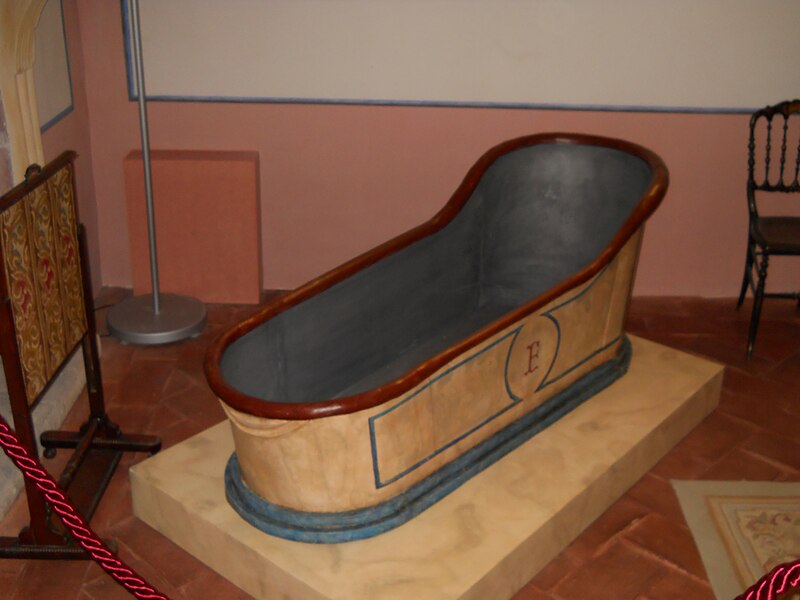Why?
Because, while the world you read about in historical romances may be accurately described down to the bootlaces, you can bet your last quid the author isn't going to give you, dear reader, an authentic version of Regency health and hygiene. We spin a fantasy world in which most people are reasonably clean, healthy, and well-groomed. We do this because we love you.
Let's take a quick gander at the Regency realities of the mundane chore abhorred by grubby boys the world 'round: taking a bath.
A bath scene in a Regency novel often focuses on how luxurious and sensual the experience is. The heroine submerges herself in a copper tub filled with warm water and sweet smelling oils. If she's lucky, the hero shows up a few paragraphs in, washes her hair with rose-scented soap and combs it dry in front of a roaring fire doubling as central heating and hormonal metaphor. Sign me up for one of those, please and thank you.
The truth is, a hot bath was a supremely luxurious experience because it almost never happened. The tub our heroine lounges in was not a fixed feature, since it was rarely used. A couple of servants lugged it up the stairs to the bedchamber. It almost certainly would have been a wooden or tin hip bath--nothing as heavy as copper--perhaps decorated with paint or a bit of marble.
 |
| This bathtub belonged to an empress. A bit of paint doesn't change the fact that an empress bathed in a glorified Del Monte can. |
The hot water used to fill the tub also had to be hauled up the stairs by servants, one bucketful at a time, from the kitchen boiler. During the Regency, many middle- and upper-class houses were equipped with rudimentary indoor plumbing. London had a water system run by private companies, and any house desiring service paid an exorbitant fee to tap into the mains. Water was carried through the city via wooden pipes prone to leaks and breaks, and the companies could cut off the water service whenever they pleased. Country houses might bring water in from a nearby river or spring. In either case, there wasn't enough pressure to get the water to floors above ground level. Thus, the kitchen-to-tub slog.
Simply preparing a bath was a time consuming, physically grueling chore. And after our lovely heroine has washed away her cares, someone has to wrangle that tub back down the stairs. Needless to say, it didn't happen very often.
 |
| Take a bath and / or stash a baby in one convenient product! |
What about the poor? They didn't have indoor plumbing. They stood in line at public pumps and carried home the water needed for cooking, cleaning, and bathing. Once lugged home, each bucketful was heated over an open range or a fire for its intended use. Imagine filling a tub like this: Stand in line, fill a bucket, walk home, pour water into kettle, wait for it to heat, pour into tub, retrieve bucket, walk to pump, stand in line, fill the bucket... In this circumstance, how often do you think your typical Londoner took what we'd consider a proper bath? My guess is round about never. The shock isn't that these people bathed so rarely, but that they bathed at all. After going to so much effort to prepare a bath, it wasn't a one-person treat. The whole family washed in the same water.
The soap used by common folk was handmade of tallow (rendered beef or mutton fat)--the same substance used for candles and cooking. Many families chose to light their homes instead of make soap with their limited tallow supply. Milled soaps, like the fancy scented stuff our heroine suds up with, were far too expensive for the working class.
 |
| Pictured: Regency spa treatment. |
As you might imagine, body odor was simply a fact of life. The nose was probably inured, to a certain extent, to the aroma of unwashed human flesh, but by no means immune. Perfumes, colognes, flowers tucked into the bodice, scented handkerchiefs, and other such devices were employed to avoid giving olfactory offense. Of course, a crowded ballroom filled with the smells of body odor and dozens of different perfumes was probably its own kind of aromatic hell.

Oh...this was fun. :) Yes, I often imagine what Shakespeare's London was like...where even Royals took baths rarely---and where the contents of chamber pots were just cast out into the street...
ReplyDeleteYAY for sanitation!
So true! I also love tweaking bathing scenes in my historical fiction, and using end up just dunking someone in a river. Thanks for the fabulous information, and for sharing.
ReplyDeleteYou're very welcome! Thanks for reading. :)
DeleteA good dunk in the river makes for a great scene, too. I remember several memorable scenes of heroes, in particular, taking a dunk in a chilly loch or stream.
??? I adore your posts.
ReplyDelete